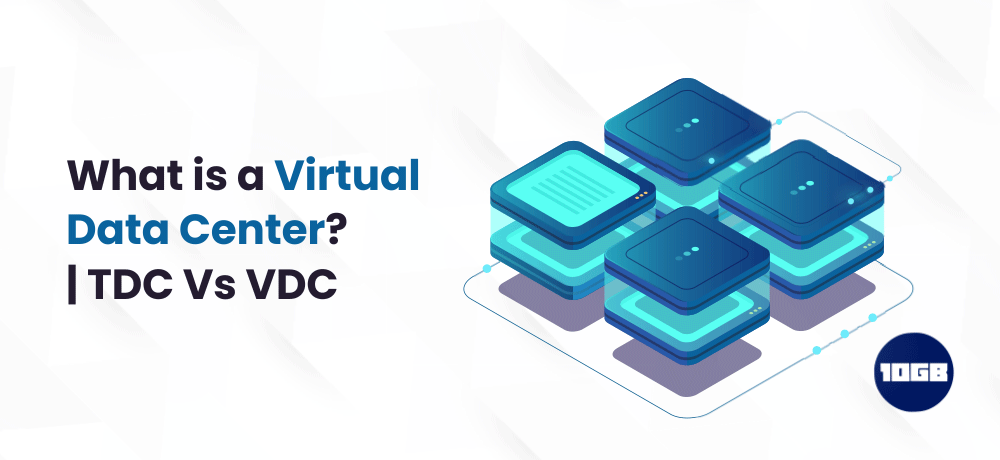Data storage, data access, and data security have become important elements of any business operation over the last few decades. Earlier, businesses used to build physical data centers to meet IT demands. However, with the recent advancements in cloud computing, several businesses shift to virtual data centers as they found them to be more cost-effective.
We have specially crafted this blog post to explain the difference between the traditional data center and the virtual data center (TDC Vs VDC).
Table of Contents
What is a Virtual Data Center
A virtual data center is a pool of cloud infrastructure resources that are specifically designed to meet the IT needs of a business. With VDC, you can easily run the business without having a need for any physical data center. A VDC is also called a software-based data center and is as efficient as a physical data center (PDC).
Similar to a physical data center, a VDC allows the setting up of servers, CPU, RAM and disk space, bandwidth, and networking components.
Additionally, VDC offers some computing capabilities like email operations, productivity apps, file-sharing operations, database platforms, CRM, ERP platforms, etc.
The main advantage of the VDC here is that you get scalable resources. So, at any time you can add or remove resources without turning off the hardware, you will only be charged for the resources you use as it follows the pay-as-you-go subscription model.
With that being said, let’s see the difference between a TDC Vs VDC.
Traditional Data Center Vs Virtual Data Center
Let’s see the difference between on-premise and virtual data centers.
Definition
VDC is a set of cloud resources that uses the virtualization method to offer computing capabilities whereas a traditional data center has an on-premise IT Infrastructure.
Main Investment Type
The investment type of VDC is OpEx as companies need to pay only for the ongoing costs only whereas in TDC the investment type is CapEx as companies need to incur hardware costs, electricity bills, cooling, and expenses for the maintenance of the IT Infrastructure.
Speed of Setting up the Data Center
It is just a matter of a few minutes to set up a VDC whereas building a physical data center takes months.
Costs
VDC follows the pay-as-you-go model so you only pay for the resource you use, on the contrary, for a physical data center, you need to invest in hardware, electricity, cooling, etc.
Hardware Allocation
In Virtual Data Center, you can observe performance issues if there are too many tenants. However, with the physical data center, you have complete access to the resources so you won’t find a drop in performance.
Server Upgrade
VDC allows easy scaling of resources whereas PDC is quite limited to upgrade options.
Migration of Data Center
VDC migration is quick, simple, and cost-efficient whereas the PDC migration is quite slow and even expensive too.
Power Consumption
VDC users don’t need to cover the expenses for electricity whereas traditional data center is huge power consumer.
Workload Migration
With VDC, you can easily migrate among the hardware platforms. However, with TDC it is a little complex to shift the workload from one hardware to another.
Antivirus and Malware Management
In VDC the antivirus and malware program operates at the hypervisor level. So, you just need one antivirus program to scan all the virtual machines. But, in TDC you need a separate antivirus program for every server in that data center.
Backup and Maintenance
Maintaining a VDC requires deep expertise whereas maintenance of a physical data center just needs coordination work and not much expertise.
Backups are managed by VDC vendors but in the case of PDC, you need backup agents.
These were differences between Traditional Data Center Vs Virtual Data Center.
Now, let’s discuss the benefits of a VDC.
Virtual Data Center Benefits
Minimize Costs
Due to virtualization technology, you can minimize the cost of purchase, maintenance, and management of the IT hardware.
Management Simplified
By using virtual servers, you can easily monitor the machines remotely and that too in real-time.
Data Security
When you choose a VDC, you can leverage a high level of systems security and advanced data protection, which can’t be compared with on-premise technology’s security.
Availability and Scalability
A VDC helps minimize the downtime as a top-tier cloud guarantees 99.999% uptime (6 mins of downtime in a year) and data recovery is too quick it happens in just a few minutes.
According to a report, more than 75% of cases of network downtime are due to human error. However, as the virtual data center eliminates the manual task it helps in minimizing the downtime issues.
Talking about scalability, VDC allows companies to adapt to various settings and requirements instantly. For instance, it allows companies to test new business models instantly without any risk, instant provisioning of resources, and adapt to the changing user needs.
Conclusion
We hope this article helped you understand the difference between a traditional data center and a virtual data center.
Additionally, you can check out our managed WordPress hosting for optimal website performance and security.
